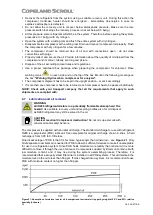
C6.2.38/0719/E
15
3.10 Sound and vibrations
WARNING
Vibration! Creation of flammable atmosphere!
Carefully check the system
for vibrations.
It is necessary to ensure that the piping design is adequate when connecting a scroll compressor to
a system.
A scroll compressor makes both a rocking and twisting motion and enough flexibility must be provided
in the pipe-lines to allow starting, stopping and steady state running of the compressor without
transmitting excessive stress into any line attached to the unit. In a split system, the most important
goal is to ensure minimal vibration in all directions to avoid transmitting vibrations to the structure to
which the lines are fastened.
Under some conditions, the Copeland scroll has a normal starting rotational motion that can transmit
a transient noise along the lines. This may be particularly pronounced in compressors using a three-
phase motor due to their inherently higher starting torque. This phenomenon, like the one described
previously, can easily be avoided by using standard line isolation techniques.
Since the variable speed scroll has a broad running frequency range (25-92 Hz), it is almost
impossible to avoid all of the natural frequencies that may exist in the system piping. The system
designer must carefully evaluate these resonant frequency conditions and either a) avoid them by
not allowing the compressor speed to align with the resonant frequency, or b) evaluate the risk and
life of the piping system when the compressor is allowed to run at frequencies that are coincident
with the natural frequencies of the piping system. If option "b" is chosen, strain gauging of the system
piping is required.
The sound level of a system is the result of design, quality and application. Scroll compressors sound
power levels generally increase with the compressor model capacity and the condition pressure ratio.
For variable speed scroll compressors, they also and mainly increase with the compressor speed.
















































